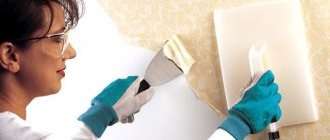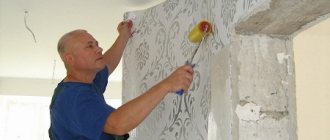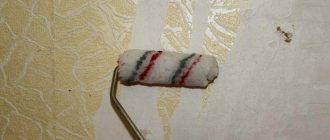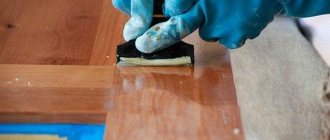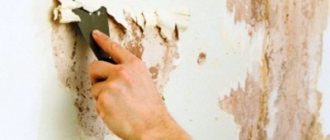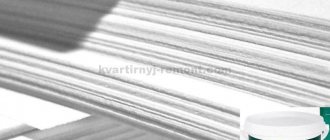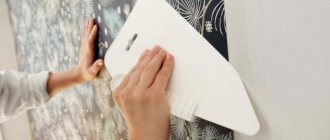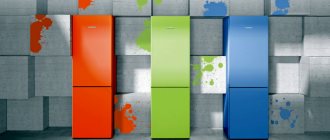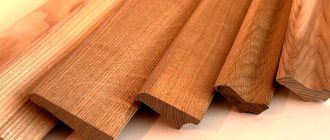How to quickly and easily remove old wallpaper
Removing old wallpaper from a wall is a long, stressful and messy process.
But if you know some little tricks, you can clean the walls in a short period of time, without spending much effort or your nerves. Removal methods depend on the type of wallpaper you have on your wall: paper or vinyl. Let's look at how you can quickly remove wallpaper from the wall yourself. First you need to protect your apartment from dirt, glue and old scraps of paper.
Lay oilcloth or old newspapers on the floor, cover furniture and anything else that needs to be protected. If necessary, use small nails to attach the polyethylene to the edges of the wall. Moving furniture from the room you are renovating will make your life easier. It is advisable to turn off the power and close the sockets.
Examine your walls from which you are going to remove wallpaper. Most modern walls are made of plaster or drywall. While plaster is hard, durable, and fairly water-resistant, drywall is nothing more than a material covered with paper and should not be allowed to get too wet.
The easiest way to tell the difference is to touch the wall in different places: if it sounds hollow, you have drywall. It is much easier to remove wallpaper from a wall covered with a thick layer of plaster or from a painted wall.
Determine what kind of wallpaper you have. There are many types of wallpaper: some come off entirely, in the entire layer (then you're in luck), in others only the top layer with the pattern peels off, and still others, especially old paper wallpaper, generally come off in pieces.
If you can't peel your wallpaper off your wall by hand (or can only peel a thin strip at a time), it's going to take some work. In such cases, use a special wallpaper remover or plain water (soap solution) at room temperature.
How to remove wallpaper from walls: effective methods
There are various ways to remove wallpaper from walls. For this, a standard set of tools, special chemicals and steam generators are used. You can also remove wall coverings using traditional methods.
Before starting repairs, it is necessary to remove the old finishing material from the surface of the walls - this is a prerequisite. Sometimes achieving this is not as easy as it might seem at first glance. There are various ways by which you can remove old wallpaper from the wall. It is these and other important nuances that will be discussed in today’s material.
Why can't you leave old wallpaper on the walls?
If you glue a fresh coating without removing the old one and without cleaning the surface, the wall will be covered with unsightly bumps and holes. Such a dubious relief will appear especially strongly under thin paper, plain non-woven fabric or paintable vinyl, or silk-screen printing.
Important! When you stick new wallpaper on top of the old ones, the weight of the coating increases, the old glue dissolves under the influence of moisture, and there is a high risk that the beautiful wallpaper will come off the wall along with everything that was on it, including the plaster. The risk is especially great if during the previous renovation the owners’ logic was similar, and several layers of paper had already settled on the walls.
When gluing wallpaper over existing wallpaper, under the influence of wet glue, fungi and mold can form under the old paper. Not only do they seriously harm your health, but they can also significantly spoil the appearance of the wall.
[vimeoyoutubepopup_video displaytype=”image” videoplayer=”youtube” videoid=”wFXOo6fp5WY” text=”How to easily remove old wallpaper” autoplay=”true”]
Which method to choose: chemical or mechanical?
Many people wonder what method to choose to remove decorative coating from a wall? It really depends on the specific situation. There are cases when paper sheets can be removed mechanically without any problems. In this case, there is no need to use aggressive chemicals. However, it also happens that it is impossible to do without them.
For example, if the wallpaper was previously “planted” with PVA glue, in this case it is difficult to do without the use of strong chemical compounds.
How to restore wallpaper fragments?
If a piece of wallpaper is torn off, you can carefully glue it back in place.
In apartments where there are small children, you can often see torn off trellises. There is no need to panic if your baby, while exploring his living space, tore a large piece of paper covering from the wall. If the torn fragment of wallpaper has been preserved, it can be easily glued back to the wall, making sure that its edges exactly coincide with the place of the break. The glued piece of trellis must be pressed tightly with a damp cloth, removing any remaining glue from its edges, and then dried with a hairdryer and leveled the restored surface with a dry cloth or roller.
It is much more difficult if the torn piece of wallpaper has not been preserved. In this case, repairing the damaged wall yourself will take a little longer. In order to restore damaged wall coverings, you need to find exactly the same trellises and cut a patch from them. Usually, large pieces of wallpaper remain after the renovation is completed. They need to be kept in good condition, then repairing the walls will not be a problem in the future. In order to restore torn wallpaper, in addition to the wallpaper itself, you need to prepare:
How to quickly remove wallpaper from a wall using a spatula and a knife
It is worth noting that this is a classic method for removing old panels. It is used by most amateur builders. The step-by-step action plan is as follows:
- using a sharp utility knife, tear a piece of wallpaper at the top of the wall;
- by the peeled edge you need to slowly pull the canvas down, preventing it from tearing;
- As the wallpaper is detached from the wall surface, it is important to use a spatula, with which you need to pry the panel from below with forward movements.
It is also recommended to pre-wet the paper wallpaper so that it is saturated with moisture. This will make the task of peeling off significantly easier, after which the canvas will come off the wall without any problems. For these purposes, it is recommended to use a regular sponge or soft roller.
The main thing is not to rush in the process of this work. You cannot sharply pull the canvas down, as it may simply tear or delaminate, which will complicate the subsequent task of removal.
Masking seams
The wallpaper joints are glued as follows:
Gluing wallpaper joints
- Using a thin brush, carefully coat the folded joints of the wallpaper.
- Then, using a roller, they are re-rolled onto the wall.
- Let the canvas soak.
Radical method. If, after diligently smoothing the wallpaper, seams have formed at the joints, then they can be successfully disguised. To do this you will need a thin brush and paint to match the color of the wallpaper. The edges of the wallpaper should be carefully pulled away from the wall, if possible. Then paint the wall at the joint and let it dry.
You can also play it safe if the preparation of the wall is not good enough, at the joints, glue paper tape (the usual one for cash registers will do) this procedure is good to carry out at the time of wallpapering the walls.
How to remove vinyl wallpaper if it is firmly stuck to the wall?
The structure of vinyl wallpaper consists of several materials: paper and polyvinyl chloride. This protects them from moisture and gives them strength. Due to these factors, problems may arise with removing these panels.
If you pre-sprinkle them with water before the removal procedure, as many do with paper wallpaper, the penetration of moisture into the internal structure of the canvas will be prevented by the polyvinyl chloride layer. What to do in this case? You need to do the following:
- Walk a sharp wallpaper tiger across the surface of the wallpaper. Due to this, the structure of the canvas is damaged, and water easily impregnates the removed finishing material.
- Using a soft roller or sponge, moisten the cloth and wait 5-10 minutes.
- Using a spatula or knife, pry up the upper part of the wallpaper and gradually, slowly pull it down.
- After removing the wallpaper, it is important to remove any remaining paper scraps with a spatula.
Thanks to this technique, you can remove vinyl wallpaper from the wall that does not want to come off. An important stage of this work is to carefully walk over the wall panel with a wallpaper tiger.
Method five: special tools
If several layers of paper have accumulated on your walls or a two-layer wallpaper covering (duplex) was pasted during a previous renovation, removing the wallpaper will be very problematic. Too old wallpaper glue, PVA or bustilate can complicate the process even more. This mixture is quite difficult to dissolve and you will probably have to scrape everything off by hand.
For these works you will need a roller with needles or a more gentle means - wallpaper tiger. You need to go over the entire surface with the tool to make holes, moisten the wallpaper with hot water: in this case, the liquid penetrates faster under the paper. We tear off pieces of old canvas with a sharp spatula or scraper, but you need to be careful: the sharp edges of the tool easily leave grooves and dents on the wall, and then you will have to further level it.
If liquid and perforating tools are powerless against the wall covering, you can use a more serious technique: a drill with an attachment for removing wallpaper (round brush) or a sander with a coarse-grained brush. Such work is very dusty, and the wall can be significantly damaged - leveling the surface with putty is inevitable.
You can clean the walls from the old coating using a drill with a special attachment.
Effective techniques
There are several effective ways to remove old wall coverings without effort:
- The wet method is known to many. It consists of moistening the paper web, after which it moves away from the wall. This option is perfect for removing loose paper-based wallpaper. This material has excellent moisture permeability. If we are talking about non-woven wallpaper, then before the soaking procedure you need to walk over it with a wallpaper tiger. After this, using a spatula, you will be able to tear the canvas off any surface.
- The dry method is suitable for old wallpaper, which can be removed from the wall without much difficulty. If necessary, it is recommended to use a spatula and a sharp knife.
- The steam method involves a combination of moisture and hot steam. This effect destroys the adhesive base of the canvas and softens it. For these purposes, use a steamer or a professional steam generator.
- The use of chemicals is justified in cases where the wallpaper cannot be removed simply mechanically. In this case, they are pre-treated with special means and then removed from the wall.
Restoration of damaged wallpaper
Repair is the most common activity that accompanies a person throughout his life. And even if it was done thoroughly, then in a year something will have to be repaired. Grease, glue and even plaster. After all, it often happens that through negligence, when moving furniture, you scratched your expensive wallpaper that was glued so carefully, but that’s nothing. And if they were torn, and even in the most visible place. What to do? How to repair wallpaper so that traces of it are not visible?
How to remove wallpaper stuck tightly to a concrete wall?
If old panels are firmly stuck to the concrete surface, they can be removed using popular chemicals.
These products are purchased from building departments. The main advantage of this method is that the special tools used will help remove the wall covering in the shortest possible time.
List of popular means
On today's market there are various products designed to remove wallpaper from various surfaces. The most popular of them are the following:
- Methylane;
- Axton;
- Kelid;
- Cleo.
When choosing a product, you should pay attention to its quality. As a rule, these products are sold only by world-famous manufacturers. The above products belong to this category of goods.
How to use
The solution is prepared from powder, in which a soft roller is moistened and the product is applied to the wallpaper. Those canvases that have a water-repellent coating must be pre-treated with wallpaper tiger.
After application, it is recommended to wait a couple of hours. During this time, the chemical will react with the glue and dissolve it. After this, the canvas is pryed at the top with a sharp object and torn off the wall.
Most manufacturers assure that such products do not contain harmful substances that pose a danger to human health. However, it is better to wear safety glasses and rubber gloves before performing such work. If the product gets on exposed skin, it is better to rinse it under running water.
Do-it-yourself repair of damaged wallpaper
The apartment was recently renovated, but the wallpaper has already become damaged? There is no need to rush to re-glue the trellises.
If there is damage to the wallpaper that is very noticeable, do not rush to re-glue the wallpaper. Damage can be disguised if you master a couple of rules for repairing wallpaper.
Scratches from pets' claws, rips, damage, and kids' wall art can be easily disguised if you know a few simple ways to repair wallpaper.
How to remove wallpaper from drywall?
When performing subsequent work, it is worth considering that it is not recommended to heavily moisten the plasterboard surface. Otherwise, moisture will penetrate the cardboard, after which it will be removed along with the wallpaper.
If the plasterboard has not yet been primed before gluing the decorative fabric, then it will be impossible to remove the wallpaper without visible damage to the plasterboard.
In this case, it is advisable to use a remover to remove the old fabric. First you need to scratch the surface of the wallpaper with a sharp knife, a toothed roller or a wallpaper tiger.
Special liquids will allow you to dissolve the glue structure, after which the decorative fabric will be removed without damaging the drywall. Special removers are applied to the wallpaper in measured quantities, according to the attached instructions. In some particularly severe cases, removal becomes significantly more difficult; for this reason, special machines and abrasives are used to remove the panels.
Types of wallpaper removers
Table 1. Wallpaper removers.
| Type | Properties | Application area |
| Acid/solvent based | Strong odor Poor moisturizing Requires special protective equipment | Superglue Bustilat |
| Alkali based | Effectively destroys the adhesive structure Requires protective equipment | For wallpaper pasted in several layers |
| Nonionic surfactant | Completely safe Excellent destruction of organic adhesives | Wallpaper in one layer For paper, non-woven and vinyl |
Axton wallpaper remover
Advantages : Saves time, easily copes with vinyl wallpaper.
Disadvantages : Alkali, it is necessary to protect the respiratory system, eyes and hands.
Prices for various types of wallpaper removers
Wallpaper remover
Video - Instructions and tips for removing wallpaper
Folk remedies
If the canvas is firmly stuck to the wall, and there is no steam generator at hand, there is a way out. Many people use an iron as their main tool. The removal method is as follows:
- the iron heats up to the highest possible temperature;
- take a damp cloth and apply it to the surface of the wall;
- After which you need to run the iron over a dampened cloth to cause steam to release.
If your home has an iron with a steam function, the task becomes much easier.
You can also do things a little differently. Some particularly resourceful builders heat water in pots to a boil and place them at the base of the wall. In this way, the steam acts on the canvas, after which it moves away from the surface more easily. Quite a difficult method, but despite this it is very effective.
And yet, the most commonly used folk remedy for removing old paintings is the use of a spatula and a wet rag. This is the method used by every second novice builder to remove wall coverings in their home. This technique can be called universal.
What is needed for repairs
As with any other type of work, before you begin, you should stock up on everything you need:
- Adhesive composition , PVA is suitable for most coatings - a high-quality composition, the price of which is low, but if the work is carried out with vinyl wallpaper, silk-screen printing and other dense coatings, then it is better to purchase a special mixture so that the fastening is truly strong and durable. As a last resort, you can prepare a little paste from flour or starch; in one of the articles this process is described in some detail.
PVA glue is a universal solution suitable for most cases
- A spatula will be needed to carefully separate all areas that are not firmly attached and to clean the wall from glue residues - you just need to scrape them off the surface.
- A few soft, clean rags will also not be superfluous; a special spatula is not needed, a rag will suffice.
- To apply the glue, you may need a brush , and if the damage is very small, you can use a cotton swab.
How to prepare for finishing?
Before you begin work on removing old decorative fabric, you need to properly prepare the room:
- Completely empty the room in which the work will be carried out from furniture. Those pieces of furniture that could not be removed for some reason should be covered with rags or film.
- You will also need to lay the floors. To prevent the film from slipping, sheets of thick cardboard are placed on it.
- Removing wall panels using water requires precautions. It is necessary to turn off the electricity and seal the sockets with plastic film. Thanks to these actions, you can prevent accidental short-circuiting.
- To prevent debris from spreading throughout your home, you need to lay a damp cloth on the threshold, and special polyethylene curtains at the entrance.
Also, before performing subsequent work, you need to ensure that you have the necessary tools.
Removing wallpaper from a wall will not be difficult only if you are familiar with the important nuances of this issue. It is important to follow the above rules and act in accordance with the designated plan. Only in this case will it be possible to cope with this task as quickly and comfortably as possible.
Instructions for use
Each product has its own instructions recommended by the manufacturer. The general scheme of work is as follows:
- Preparing the room . It is necessary to empty the room of furniture as much as possible, cover the remaining interior items with plastic film, seal sockets and switches with tape.
- Preparing wallpaper . In order for the liquid to penetrate better, the surface must be damaged. A Tiger wallpaper or a needle roller is suitable for this.
- Preparation of the product . The composition is diluted with water, strictly following the manufacturer’s recommendations.
- Application of the product . The composition thoroughly wets the surface of the walls, leaving no dry areas. The liquid can be applied with a roller or brush.
After application, you must wait 10-15 minutes , after which the sheets are removed with a spatula. Remaining liquid is removed from the walls with warm water or soap solution.
Basic methods for removing old wallpaper
If you're very lucky, the wallpaper comes off on its own.
Not themselves, of course, but separating them from the walls does not require any special means, moisture, or any significant effort. The canvas is picked up from above and gently pulled towards itself and down.
If the wallpaper comes off easily, then the work will not require much time and effort.
By the way, it is not recommended to make great efforts. Over time, paper webs can acquire a certain fragility and begin to tear if they are pulled too hard. You should try to remove the entire sheet completely, from top to bottom. “Resisting” areas should be cleaned immediately with a sharp spatula or even a knife.
It is not excluded, of course, that in the course of such a successful “dismantling” there will still remain separate “islands and continents” that do not want to part with their place. Well, then the finishing on the main area is removed, and for these “rebels” we will use one of the more radical methods, which will be discussed below.
Water comes to the rescue...
The case described above is one of the exceptions. This usually happens if the wallpaper was initially glued not very well, and the owners were simply lucky that it lasted so long.
And the most common method, which most often helps out, is to blot old wallpaper with water. Firstly, the canvases themselves swell, and this already contributes to their separation from the wall. And secondly, abundant moisturizing leads to the dissolution of the old adhesive layer, and it will no longer hold the wallpaper dead on the surface.
Another advantage of this method is that the worker does not have to “swallow” clouds of dust that inevitably arise when removing wallpaper using the “dry” method. True, as a cost, it is difficult to avoid the formation of wet dirt on the floor. But if there is film there, everything can be easily removed.
So, the task is to saturate the canvases themselves as much as possible with moisture and cause the glue to dissolve. To do this, it is recommended to use warm water, which is applied with a sponge or foam roller. For many, it is more convenient to use a spray bottle attached to an ordinary plastic bottle for this purpose. They try, of course, to apply water with a certain moderation, so as not to create streams along the walls and, accordingly, puddles on the floor.
Moisturizing old wallpaper on the wall can be done using a sponge, foam roller or spray bottle
After moistening, it is necessary to take a short pause so that the moisture is well absorbed into the structure of the material and softens the adhesive layer. For simple single-layer paper wallpaper, literally five to seven minutes is enough, and you can start removing it. Multilayer ones will require more water and time. But even with them, after 15 ÷ 20 minutes the surface will be ready for cleaning.
So, after the canvases on the wall are saturated with water, you can begin to remove them. Again, if you’re lucky, the removal will occur, if not in whole sheets, then at least in large fragments. However, when exposed to water, old wallpaper can begin to “creep” and tear, and you have to use spatulas or special scrapers.
Most often, a regular spatula helps out at home. Professional finishers may also have special scrapers in their weapons.
They begin to remove the sheet either from the top, or, if it seems more convenient, from the seam - they pry up the sheet with a spatula, and try to carefully peel off a fragment of the largest possible area from the wall. The remaining areas are cleaned individually. If necessary, some areas of the finish that do not want to move away from the wall are moistened additionally.
Of course, when scraping off the remnants of wallpaper, you should exercise some care, trying not to leave grooves on the layer of plaster or putty. Especially if the plans do not include subsequent leveling of the surface, that is, the new wallpaper will immediately be pasted onto the cleaned wall.
The method is effective, and in addition, its effectiveness can be enhanced in several ways.
Features of preparation for “wet” removal of vinyl wallpaper
Thick washable wallpaper, and especially those with a vinyl waterproof outer covering, require special preparation. Their surface does not allow moisture to pass inside, to the wall, which means that it is necessary to artificially create the conditions for this.
You can damage the integrity of the outer waterproof coating by making notches using a regular knife, but this is not entirely convenient. Such an operation will be performed faster and with better quality using a special roller with sharp needles. Or a special tool is used - a wallpaper tiger. Its toothed rollers, when moving along the surface, leave quite deep grooves on the finish without damaging the wall itself. Such scratches are quite enough for water to penetrate through the waterproof layer and do its job.
Violating the integrity of the waterproof surface layer of wallpaper using a wallpaper tiger or a needle roller
After this, they proceed to removing the canvases - in the same sequence as described above. By the way, after getting the bottom layer wet, heavy vinyl wallpaper can often be removed much easier than paper wallpaper - in whole sheets. But some types delaminate, that is, first the top vinyl layer is removed, and then you have to additionally remove the bottom paper or non-woven base.
Find out how to glue vinyl wallpaper yourself in a special article on our portal.
How to increase the efficiency of the “wet” method of wallpaper removal
It also happens that even after getting wet, the wallpaper still “resists” and does not want to move away from the wall. This means that you can use some tricks and enhance the effect of water by introducing some additives into it.
- Even a simple dishwashing detergent added to warm water will significantly improve the efficiency of the work.
- Often wallpaper was previously glued using PVA, and this poses a very serious problem. This composition, after complete drying, is practically unaffected by water, and stronger agents have to be used. The simplest, but very effective - using ordinary laundry soap.
A concentrated solution of laundry soap can cope even with very firmly “sitting” wallpaper.
The soap bar should be grated. The shavings are filled with water (4÷5 liters), and this mixture is brought to a boil. Then the composition is diluted to 10 liters - and it should cope with even very difficult cases.
- Regular 9% table vinegar also helps in peeling wallpaper from the wall. It is added to water in the proportion of a half-liter bottle to a bucket of water.
Regular 9% table vinegar can also be a reliable helper.
By the way, a mixture of the soap solution recommended above and vinegar can cope even with wallpaper that is very deeply ingrained into the wall.
- Not everyone wants to deal with soap and vinegar - simply because the odors are not particularly pleasant. In this case, such “aesthetes” can be recommended to use fabric conditioner.
Conditioner-rinse in a non-traditional use for it - for removing wallpaper, shows very good efficiency.
To prepare a “working solution”, you can proceed from the proportion - 300 ml of conditioner per bucket of water.
- It sounds paradoxical, but to peel heavy wallpaper from the wall you can use...wallpaper glue. True, its concentration should be approximately half as low as during finishing. The special consistency of the glue binds water and prevents it from quickly evaporating and wet wallpaper from drying out quickly. After the canvases are well saturated with moisture, they are removed in the usual way.
- Professional builders and finishers, who often have to deal with very large-scale tasks, use another very effective method. An unexpected application is found in liquid for clearing clogged sewer pipes - the well-known “Mole”.
The active chemical formula of “Mole” helps to quickly remove old wallpaper and copes with very difficult cases.
“Mole” is diluted with ordinary warm water in a ratio of approximately 1:2. The resulting solution moisturizes the wallpaper abundantly, for example, using a roller on a rod. The effect should be noticeable within literally ten minutes - as a rule, the canvases are removed without any resistance entirely or in large fragments - this is facilitated by the active chemical formula of the organic solvent.
The disadvantages of this method include the fact that you will have to carefully protect your hands from the effects of such chemicals - it can cause quite serious skin irritations. Well, the wall itself will require thorough washing after removing the wallpaper.
Special compositions for removing wallpaper from the wall
If you need to remove very well-pasted wallpaper without delaying the work, and funds allow, you can purchase a special liquid designed specifically for such purposes. Its effectiveness is significantly higher than even the previously mentioned soap solutions.
However, there is no need to talk about too much spending - the cost of such compositions seems quite affordable, and at the same time, one bottle (packaging) is usually enough to treat 100 or more square meters of walls.
The table below shows examples of such compositions - among the most popular:
| Composition name | Illustration | Brief description of the product | approximate cost |
| Concentrated wallpaper remover "Axton" | Domestic product. Requires dilution with water in a ratio of 1:20. A standard 500 ml bottle should be enough to cover up to 150 m². Does not contain organic solvents. Copes with the removal of any type of wallpaper, including those pasted in several layers. | 200 rub. | |
| "Quelyd Dissoucol" | Products of a famous French company. Easily copes with washing off many types of finishes (for example, removing old whitewash), including wallpaper, from thin to heavy. Concentrate that requires dilution in accordance with the attached instructions. A 250 ml bottle is enough to treat up to 80 m² of wall. | 380 rub. | |
| Henkel Metilan | The composition of the German manufacturer, which has earned many positive reviews. Odorless, simple and effective to use. A concentrate that requires dilution with water to a working state. The capacity of a standard bottle is 500 ml, which should be enough to treat up to 200 m². | 280 rub. | |
| Pufas TAP-EX | Product made in Germany. Concentrate that requires dilution with water. Copes well with the most complex cases. Suitable for old adhesive paint layers. Concentrate - 1 bottle of 250 ml is diluted in 10-12 liters of water, which is enough to remove up to 70 m² of wallpaper. | 140 rub. | |
| Neomid 300 | Domestic product. Concentrate diluted with water in a ratio of 1:19. Consumption – from 100 to 300 ml/m² of the finished solution, depending on the density and number of layers of wallpaper. Standard packaging of the concentrate is a 1 liter bottle. There are also ready-made compositions on sale - in bottles with a spray bottle, designed to treat about 5 square meters of wall. It has a disinfecting effect, that is, in parallel with washing, an antiseptic surface treatment is carried out | 210 rub. for 1 liter of concentrate |
There are many other liquids from various manufacturers, but the reader must have gotten a rough idea of the packaging and price level.
Any composition is accompanied by detailed instructions for use - indicating the dilution proportions for various cases, the order of application to the wall, the duration of the technological pause before removing the paintings.
As a rule, such compositions are completely safe for humans and pets and do not cause damage to the environment. That is, after use, they are split into completely neutral components.
However, when working with such chemicals, you should still adhere to certain precautions - this must be stated in the instructions. In addition, it should immediately clarify the question of whether the walls require additional rinsing with clean water after such cleaning.
Find out which wallpaper is best to choose for painting in a special article on our portal.
We are calling for couples to help...
If you don’t want to leave the wallpaper “dry” from the wall, but you can’t create dampness in the room in order to wet it through, or you can’t for some reason, or you really don’t want to, you can use steaming technology. The combination of elevated temperature and the vapor state of water gives a very good effect - the canvases begin to be easily separated from the walls, even in quite difficult cases.
It is clear that in order for steam to penetrate to the surface of the wall, certain conditions are necessary. That is, to remove those wallpapers whose surface layer does not allow moisture to pass through (vinyl, etc.), you will still have to first work on perforating their surface with a knife, a needle roller or a wallpaper tiger. Paper and non-woven fabrics do not require such an operation.
For direct steaming, you can use three different methods.
- The simplest is to use a regular iron. It is heated to maximum, and then the wallpaper is ironed in sections through a heavily moistened cloth. We do something similar when we iron, for example, clothes.
This approach, of course, cannot be called convenient. And above all, because it will be extremely difficult to cope alone - there simply aren’t enough hands. One person will have to lay a damp cloth on the surface of the wall and hold it in that position, and the second person will have to carefully iron this area. And then, without allowing the treated area to cool, you must immediately clean it of the coating. It is clear that work begins either from the top or from the side seam.
- It is much easier to work, even alone, with an iron equipped with a vertical steam function. Powerful steam action can quickly soften both the wallpaper itself and the layer of glue underneath it, and usually the section of the canvas can be removed after such treatment without any problems.
An iron with a vertical steaming function - after using it, the wallpaper should come away from the wall without much resistance.
Laying a thin fabric before processing also doesn’t hurt. But for reasons such as not to contaminate or even damage the soleplate of the iron with possible dirt or plastic floating from the high temperature.
It is clear that the necessary safety measures must be observed. Through inattention or carelessness, it is quite possible to earn yourself a painful burn either from touching a hot sole or from contact with a stream of steam. So the operation should be carried out while protecting your hands with seals.
- Finally, the most convenient tool for steaming wallpaper is a special device. It is called a steamer, or also a steam stripper.
The device can be seen using the example of a fairly common uncomplicated model “QUATTRO ELEMENTI Vapore W-2400”
A convenient tool for removing any type of wallpaper – steamer “QUATTRO ELEMENTI Vapore W-2400”
The device kit includes the following components and devices:
The base of the device (item 1) is itself a steam generator. Up to 4.2 liters of water are poured into it through the neck with a stopper (item 2). On the bottom rear (not shown in the illustration) there is a power supply that connects to a 220 V outlet with a power cord.
A flexible hose (item 4) 3.6 meters long is connected to the outlet pipe of the steam generator (item 3) using a convenient quick-release fitting system (item 5). This length allows you to work without problems even with high ceilings in the room.
The main working body is the steam platform (item 6). It has quite impressive dimensions (200x280 mm), which allows you to immediately capture a fairly large area. Convenience of working with this platform is ensured by the handle located on top (item 7), which does not heat up to high temperatures.
The weight of the entire set (excluding water filling) is only 2.4 kilograms. That is, it is not at all difficult to move the steamer to a place convenient for work, especially since there is a handle on the base body for this purpose.
After filling with water and connecting to the network, steam begins to be produced within 6 minutes, and after 11 minutes the device reaches optimal mode. One filling with water is enough for non-stop operation for an hour. Steam generator productivity – 45 g/min. Power consumption – 2000 W. Overheating protection is provided - if the water in the tank runs out and the owners forget to refuel in a timely manner, the power will automatically turn off.
Removing old wallpaper using a special steamer is perhaps one of the most effective and neat methods
Probably everyone can work with this or a similar device. Very fast and convenient - one hand guides the smooth movement of the steam platform, and as it moves with the other hand, the wallpaper is immediately separated from the wall. If necessary, the area can be steamed several times.
Of course, not everyone has such a device. But if there is a large-scale renovation ahead, then sometimes it’s worth thinking about buying such a convenient device. The price of the kit shown above is not particularly scary, around 3200–3500 rubles. And it will be absolutely wonderful if you can agree to rent a steamer for a certain period of time necessary for high-quality cleaning of all the walls in an apartment or house.
Some features of cleaning plasterboard surfaces from wallpaper
Drywall has become widespread due to its ability to level walls very quickly and efficiently. But along with a lot of advantages, such coatings also have their weaknesses. In particular, it can be much more difficult to remove old wallpaper from such a wall than from a solid wall (brick or concrete) covered with plaster.
Everything is explained simply:
— Firstly, the walls should not be allowed to become too wet - both the top layer of cardboard and the plaster underneath can become very wet, and the plasterboard will lose its former strength.
“Secondly, mechanical cleaning methods must be used extremely carefully. Excessive force or, for example, awkward movement with a spatula (scraper) can damage the integrity of the cardboard covering.
What to do?
- If before gluing the wallpaper the wall was covered with a thin layer of putty, then you can use the “wet” method of removal, for example, using special liquids.
- A liquid adhesive composition, similar to what was previously used for finishing, can also help. On the one hand, little liquid is used in this case, but since it will take a long time to dry, it should be enough to completely soak the old coating, and it should separate.
- It is better to refuse mechanical cleaning a priori, and if the tried methods do not produce results, it is worth using steaming.
Let us emphasize once again the importance of one point. Since covering walls with plasterboard sheets often gives a very smooth surface, there is a temptation to glue wallpaper directly over it. This is a very serious mistake! Paper or non-woven wallpaper glued to cardboard adheres almost tightly, and removing them without damaging the cardboard covering of the wall is almost impossible with any cleaning method. So before finishing, you should always cover a plasterboard wall with a thin layer of putty - and there will be no problems in the future.
We learn how to putty walls before wallpapering.
This operation is all the more necessary if you plan to use thin wallpaper that is not capable of masking minor surface defects or color spots on it. The task is important, not easy, but still doable - you can see this by reading the special article on our portal “Puttying drywall for wallpaper .
A few final important notes
Concluding this publication, let’s consider a few more nuances regarding certain situations when removing wallpaper.
- If the wallpaper is two-layer on a non-woven basis, then it often happens that only the top decorative layer can be removed. And the non-woven base remains on the wall. It can not be torn off using brute force, but used as a kind of reinforcing coating by applying a thin layer of putty to it after priming. After leveling and sanding, the wall will again be fully ready for any type of finishing.
By the way, fragmentary remains of paper wallpaper, if they are not shaggy outward and are firmly glued to the wall, can also be hidden with a layer of putty. This should not affect the quality of future finishing.
Sometimes it is easier to completely cover the wall with a thin layer of putty than to ensure that it is completely clear of small scraps of wallpaper that do not want to come off.
- Removing liquid wallpaper usually does not present any special problems. At its core, it is a kind of plaster layer on a cellulose adhesive base. After softening with water or any other composition mentioned in the article above, the coating can be cleaned off quite easily with a spatula. Moreover, some craftsmen do not even throw away the composition cleaned from the wall - it can be reused after appropriate processing.
What is this - liquid wallpaper?
Many people have never even heard of this finishing method. Meanwhile, it opens up the widest possibilities for original interior design. And what’s interesting: applying and even making liquid wallpaper with your own hands is not such a prohibitively difficult task. Read about this in a special publication on the portal.
- Glass wallpaper also stands apart. They are glued to a special adhesive composition with a high content of polyvinyl acetate or acrylic resins, and this glue almost completely binds their fiber structure through and through.
Removing high-quality fiberglass wallpaper glued to the wall is an extremely difficult task.
And in principle, it’s not particularly necessary... Separating them from the wall using the methods listed above is a task that with a 99% probability will end in failure. Use mechanical methods using abrasive nozzles, hard brushes, etc. – it’s possible, but is it worth it?
— Firstly, glass wallpaper can withstand more than ten (some up to thirty!) cycles of repainting. That is, it is quite possible to update the interior design without even cleaning the walls.
- And secondly, if an absolutely flat, clean surface of the wall is absolutely necessary, then high-quality glass wallpaper becomes an excellent “reinforcing mesh”, on which a layer of putty can be placed without any problems.
Find out how to glue glass wallpaper for painting, and also familiarize yourself with the theory, calculations, and practice of proper gluing on walls in a special article on our portal.
By the way, one of the modern finishing technologies directly involves the preliminary reinforcement of walls with fiberglass “gossamer” before they are puttyed. And this fiberglass is nothing more than the same glass wallpaper of low thickness and density. So you can cover them with putty without fear.
What is the painting fiberglass “gossamer” used for?
This material appeared on the shelves of construction stores relatively recently, but has already proven the convenience and effectiveness of its use. What is painting fiberglass “gossamer” and what are the possibilities of its use - read in a special article on our portal.
* * * * * * *
So, the article discussed some, from the author’s point of view, the most convenient ways of removing old wallpaper from the wall. Of course, many finishing craftsmen may have their own opinion on this matter and apply their own methods. It would be great if they shared their know-how on the pages of our portal.
At the end of the publication there is a video in which one of the masters shares his secret.
